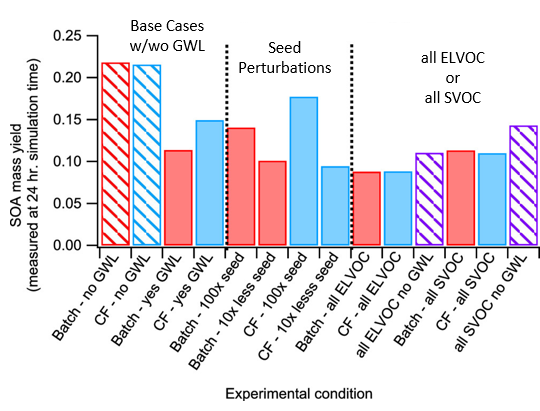Effects of gas-wall loss on SOA yields in Teflon chambers: Continuous flow versus batch modes
Submitter
Jimenez, Jose-Luis — University of Colorado
Day, Douglas A. — University of Colorado, Boulder
Area of research
Aerosol Properties
Journal Reference
Science
Gas-phase wall losses and effects on chamber-based secondary organic aerosol (SOA) yield measurements were evaluated for “batch” versus “continuous flow” operational modes using an experimentally constrained model. It is shown that despite previous claims to the contrary, gas-phase wall losses occur for both modes and require correction for accurate yield values.
Impact
Yields of SOA formation from oxidation of volatile organic compounds are measured in laboratory chambers and then applied in regional and global models. Gas-phase losses to large Teflon-walled environmental chambers have been recently shown to reduce SOA yields. Historically, most chambers have operated in “batch” mode. Increasingly, however, “continuous flow” (CF) mode is being used, in which reactants and products are continuously introduced and exhausted from the chamber. Recent literature reports indicate a belief that SOA yields measured in CF chambers are not affected by gas-phase wall losses (GWL) shown by low seed-dependence of yields. Overall, this work shows that in fact gas-phase wall losses occur in CF and batch chambers and both require correction for accurate yield values even in experiments with high starting seed levels. The results and methods will help in interpretation and experimental planning for SOA-formation chamber experiments.
Summary
To investigate the effect of GWL in the different chamber modes, we used an experimentally constrained box model representing the chemical production, gas-particle-wall partitioning phase transitions, and flows. The chamber experimental conditions modeled were designed to approximate a published chamber study of ɑ-pinene ozonolysis with ambient level concentrations and seeded with ammonium sulfate. Two classes of partitioning product compounds were formed, semi-volatile and extremely-low-volatility organic compounds (SVOC, ELVOC), which can partition into the particle phase (forming SVOA, LVOA) or into the chamber walls, and the SVOC can partition back to the gas phase from the particles and walls. The study clearly shows that gas-phase wall losses impact both types of chambers when run under similar conditions, but magnitudes and relative differences depend on various factors. We found CF experiments do mitigate some effects of gas-phase wall losses after long (>2 days) experiment run times, but they have substantial losses for typical literature experiment times of 1 day. However, the mitigation phenomenon found for the CF mode is experiment- and mechanism-dependent, and GWL still affects the absolute SOA yield. We show that at particle condensation sink values higher than the gas-wall loss rate, a lack of change in yield versus seed surface area does not necessarily indicate whether GWL affects the experiment and does not suggest the magnitude, in contrast to assumptions to the contrary found in recent literature. Wall losses are largest in all types of chambers at low “atmospherically relevant” conditions and are substantially reduced at higher concentrations. Generally, vapor wall loss effects on yields result from the near immediate competition of ELVOC (irreversible) condensation to walls (versus particles) and the long timescale (days) for SVOC to reach equilibrium with chamber walls.



